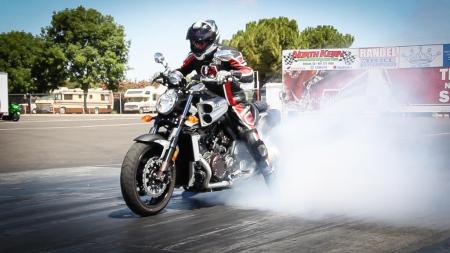2012 Star VMAX Review - Motorcycle.com
Like a good Chuck Norris joke (Chuck Norris doesn’t call the wrong number, you answer the wrong phone), the legend of the Star VMAX has become greater than the actual motorcycle. That’s not to say the VMAX isn’t a fire-breathing hell-spawn that eats lesser two-wheelers. On the contrary, the VMAX retains its title as the awesomest power-cruiser ever by virtue of its incredible performance, menacing good looks and cult status. When a VMAX is given full throttle, it feels as if the rotation of the earth speeds up.
All motorcycles derive personality characteristics from the performance, sound and power delivery of their motor but the VMAX is the epitome of a motorcycle defined by its engine. The 2012 MAX boasts a Brembo radial pump master cylinder controlling its dual front 6-piston brake calipers, ABS, a slipper clutch, ride-by-wire, an aluminum frame, etc., but this hardware pales in comparison to the 176 rear-wheel horsepower of the MAX’s 1679cc, V-Four powerplant.
“If you’re into tire-spinning acceleration, the Max is the undisputed king of burnouts thanks to its outrageous power and shaft-driven rear wheel that has a harder time hooking up than a chain-driven bike,” says chief tire smoker, Kevin Duke.
Revered among acceleration junkies for its original “V-Boost” system – where each cylinder is mated to a single 35mm carburetor until a butterfly valve opens at 6,000 rpm allowing the fuel mixture from all four carburetors to feed a communal chamber from which each cylinder draws, resulting in a white-knuckle experience of forward motion. The new MAX, reborn in its current version in 2009, is fuel-injected, not carbureted, so YamaStar had to devise a new kind of V-Boost system.
Now, the Yamaha Chip Controlled Intake (YCC-I) and Yamaha Chip Controlled Throttle (YCC-T) replace the butterfly effect of the old model. At 6650 rpm, the YCC-I shortens the length of the intake tracks from 150mm to 54mm in 0.3 of a second, while the YCC-T controls the throttle valves by computing input from a variety of sensors and calculates the best combination of EXUP setting, throttle position and ignition advance. The end result is a VMAX that doesn’t lunge forward as dramatically at a specific RPM, but rather uses technology to smooth and broaden the power delivery.
In a twist of irony, it’s now the ungracious deceleration we found to be intrusive. “The riding characteristic I cared for least is its annoyingly abrupt engine-braking response when off the gas,” says Duke. Considering this is the third year of the new VMAX’s existence it’s surprising YamaStar hasn’t programmed this effect out of the bike. It’s not like the VMAX isn’t equipped with the technology to smooth the transition between on- and off-throttle.
With 66.9 inches between contact patches (0.4 inches more than a Gold Wing) the VMAX is long, but it’s also wide. “Astride Mr. MAX, the dominant impression is of a seat as wide as a touring bike’s,” notes Duke. “This provides good support, but it forces short legs to struggle reaching the ground.” In other words, the bigger you are, the less you’ll be intimidated if/when the 683-pound (wet) VMAX gets somewhat off-balance.
For its size and weight, as well as its 18-inch wheels, the VMAX manages curvy roads with better-than-expected competency, but athletic the bike is not, unless you’re speaking of the power-lifting or shot-putting kind of athletics. Although we did not detect any chassis flex when forcing it through a corner, “The VMAX’s narrow bars and considerable weight slow steering-transition responses,” Duke says.
Fuel economy should be the least of concerns for anyone looking to purchase a VMAX, but we’ll mention here that we observed an average 33 mpg. With its 4.0 gallon fuel tank, you’ll get 132 miles before you’re walking, and that’s no lie. On our return trip from Famoso Dragway near Bakersfield, we rode 30.8 miles with the low fuel light illuminated. When a gas station finally presented itself, there was 125.2 miles on the clock and it took 3.78 gallons to top off.
Ride the VMAX the way it’s supposed to be ridden and you’ll do much worse (26.3 being our lowest mpg). And that’s exactly the point when it comes to VMAX ownership. To hell with fuel economy, protective fairings, aerodynamics and pretty aesthetics – that’s not what this bike is about.
Although refined from its former V-Boost ways, the VMAX still embodies the elemental forces that are appealing in much the same way of ’60s muscle cars. In fact, according to Duke, “with its giant V-4 motor between your legs, it feels almost like you’re riding a motorcycle with a car engine.”
The 2012 Star VMAX is a combination of internal combustion bravado and industrial design no other motorcycle can match. And let’s not forget its V-8 sprint-car sound. When it comes to power and presence, the VMAX remains the king of the power-cruisers.
Related Reading
2013 Victory Judge Review
2012 Ducati Diavel Cromo Review
2009 Star V-Max Review/Test
2009 Harley-Davidson VRSCF V-Rod Muscle Review
1998 Muscle-Bike Shootout: Matchup of the Heavyweight Contenders
More by Tom Roderick


































Comments
Join the conversation